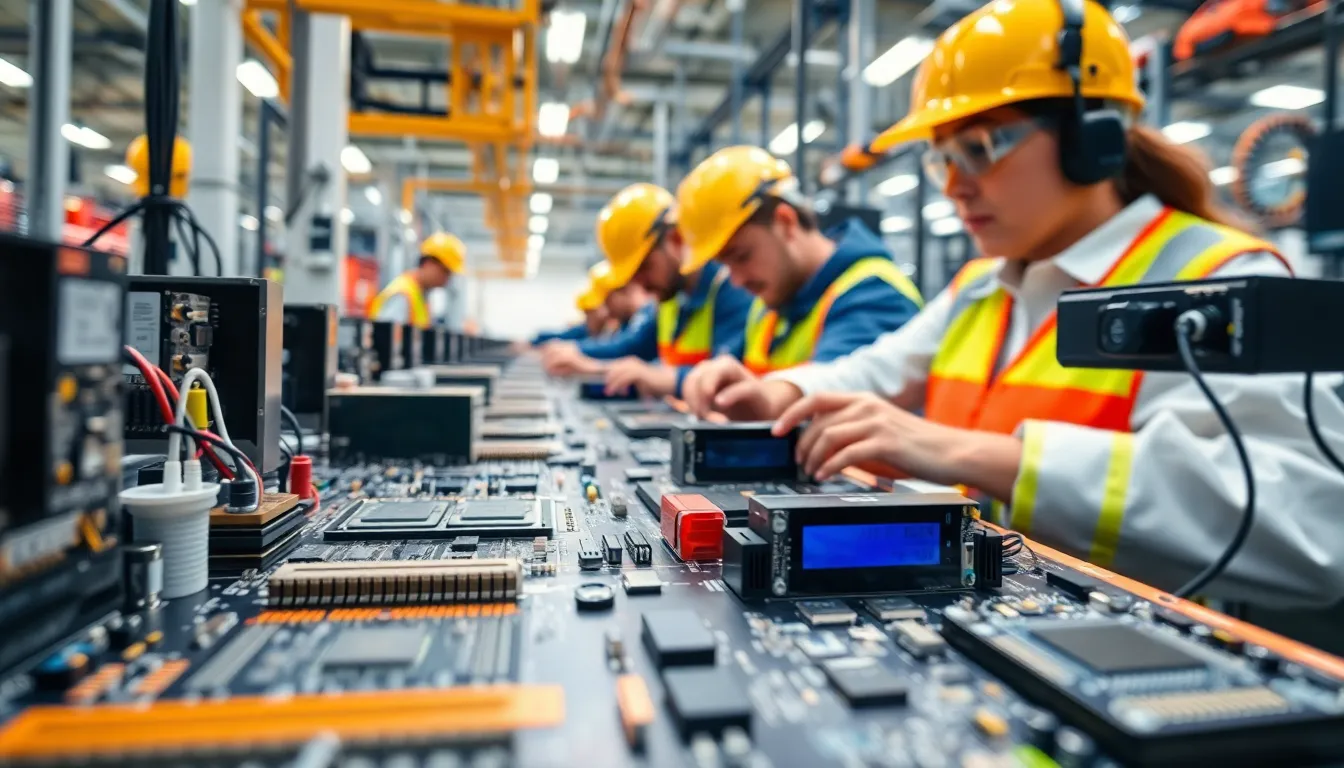In a world where smartphones are practically an extension of our hands and smart fridges can order groceries, consumer electronics manufacturing is the unsung hero behind the scenes. It’s a fascinating dance of innovation, precision, and just a sprinkle of chaos that brings our favorite gadgets to life. Ever wonder how your phone can fit a thousand songs in your pocket while also making you coffee? Spoiler alert: it’s not magic—it’s manufacturing genius.
Table of Contents
ToggleOverview of Consumer Electronics Manufacturing
Consumer electronics manufacturing involves the design and production of devices used in everyday life, such as smartphones, tablets, and home appliances. This sector plays a vital role in driving technological advancements and satisfying consumer demands.
Definition and Importance
Consumer electronics manufacturing refers to creating devices that enhance daily living. This manufacturing sector’s significance stems from meeting consumer needs while fostering innovation. Businesses leverage advanced technologies to develop products that blend functionality with appealing design. As a result, consumer satisfaction and market competitiveness increase, contributing to economic growth.
Key Sectors Involved
Several sectors contribute to consumer electronics manufacturing, including materials, assembly, and testing sectors. The materials sector supplies components like semiconductors and displays, which serve as the foundation for various devices. Assembly focuses on integrating these components into final products, ensuring quality and efficiency. The testing sector conducts rigorous evaluations to guarantee that products meet performance standards before reaching consumers. Each sector plays a distinct role in delivering innovative and reliable consumer electronics.
Major Components of Consumer Electronics

Consumer electronics consist of two primary components: hardware and software. Both play vital roles in shaping the functionality and performance of devices.
Hardware Components
Hardware components form the physical foundation of consumer electronics. Key elements include microprocessors, circuit boards, and displays. Microprocessors act as the brain, executing instructions and performing calculations. Circuit boards provide the necessary pathways for electrical signals, connecting various components. Displays, such as LCDs or OLEDs, visually present information, enhancing user interaction. Components like batteries and casings protect internal elements while providing power and durability. Each hardware component integrates seamlessly, ensuring reliability and efficiency in everyday devices like smartphones and smart fridges.
Software Integration
Software integration enables hardware components to function harmoniously. Operating systems manage device operations, ensuring smooth interaction between hardware and applications. Firmware controls specific tasks within devices, optimizing performance. Developers create applications for various functions, expanding device capabilities. Cloud services facilitate storage and connectivity, enhancing user experience through features like data synchronization. Updates improve security and functionality, keeping devices relevant over time. This comprehensive software integration ultimately transforms hardware capabilities into user-friendly features.
Manufacturing Processes in Consumer Electronics
Manufacturing processes in consumer electronics encompass various stages, from design to production techniques, all crucial in delivering advanced devices.
Design and Prototyping
Design and prototyping serve as the foundation for creating consumer electronics. Engineers focus on formulating ideas, creating initial layouts, and selecting appropriate materials. Various software applications assist in generating 3D models, allowing for virtual testing and modification. Rapid prototyping techniques, such as 3D printing, enable teams to create physical models quickly. Feedback is integral to this phase, as user testing illuminates areas for improvement before full production.
Production Techniques
Production techniques in consumer electronics emphasize efficiency and precision. Automated assembly lines facilitate the mass production of devices, significantly reducing time and labor costs. Techniques like surface mount technology expedite the process of attaching components to circuit boards. Quality control measures, including rigorous testing at multiple stages, ensure that products meet high standards. Just-in-time manufacturing continues to gain popularity, minimizing inventory costs and streamlining supply chains.
Supply Chain Management in Consumer Electronics
Supply chain management plays a vital role in consumer electronics manufacturing. It encompasses various processes that ensure efficient production and delivery of devices.
Sourcing Materials
Sourcing materials involves selecting high-quality components essential for device production. Manufacturers rely on a global network of suppliers for key materials like semiconductors, metals, and plastics. Strategic partnerships with trusted suppliers reduce risks associated with material shortages. Organizations often seek sustainable and eco-friendly materials to meet growing consumer expectations. Quality assurance checks confirm that sourced components meet industry standards, preventing defects in final products.
Logistics and Distribution
Logistics and distribution coordinate the movement of materials and finished products throughout the supply chain. Efficient transportation systems ensure timely delivery to assembly plants and retailers. Many manufacturers use advanced technologies and analytics to track inventory levels and forecast demand accurately. Streamlining distribution networks reduces costs associated with warehousing and transportation. Real-time data visibility supports faster decision-making while enhancing responsiveness to market changes.
Trends Shaping Consumer Electronics Manufacturing
Consumer electronics manufacturing evolves rapidly, influenced by technological advancements and a growing emphasis on sustainability.
Advancements in Technology
Emerging technologies reshape the consumer electronics landscape. Artificial intelligence and machine learning enhance device functionality, allowing for smarter, more responsive products. 5G connectivity propels the speed of data transfer, leading to better experiences for users. The Internet of Things connects a myriad of devices, fostering seamless integration within smart homes. Advanced materials, such as flexible displays and lightweight alloys, improve product design and performance, making devices more appealing and efficient. Innovations in manufacturing, like additive printing, streamline production and enable customization at scale.
Sustainability Practices
Sustainability practices play a vital role in consumer electronics manufacturing. Manufacturers prioritize eco-friendly materials, ensuring that components are recyclable or biodegradable. Energy-efficient processes reduce carbon footprints, with factories implementing renewable energy sources. Supply chains increasingly focus on sourcing responsibly, emphasizing ethical labor practices and reducing waste. Closed-loop systems allow for the reuse of materials in production, minimizing environmental impact. Consumer demand for sustainable products drives manufacturers to innovate and adopt green initiatives, reflecting a shift towards a more responsible approach to electronics production.
Consumer electronics manufacturing stands at the forefront of innovation and technology. Its ability to merge engineering expertise with cutting-edge design results in products that enhance everyday life. As manufacturers adapt to emerging trends and prioritize sustainability, they’re not just meeting consumer demands but also shaping the future of technology.
The ongoing evolution in manufacturing processes and supply chain management ensures efficiency and quality, paving the way for reliable devices. By embracing advanced technologies and sustainable practices, the industry is poised for continued growth and transformation. As consumer expectations evolve, the commitment to innovation will remain a driving force behind the next generation of electronics.



